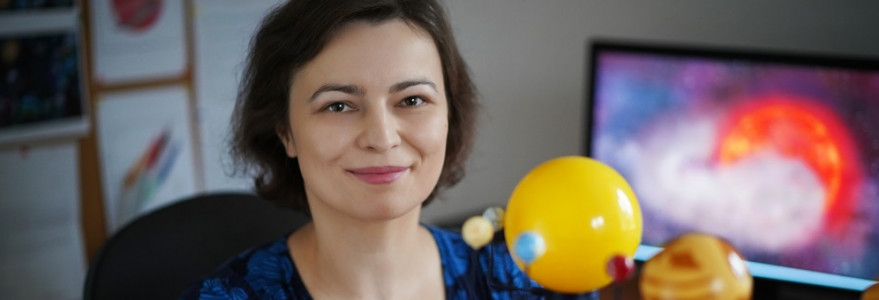”Planets, especially the extrasolar ones, have always fascinated people. We wonder if there is life on other planets and whether we’ll meet the inhabitants of other worlds. For us, astronomers, it is very important to discover a large number of extrasolar planets, so that we can better understand how and where planetary systems can form,” said Dr Dorota Skowron from the Astronomical Observatory of the University of Warsaw, the ERC Starting Grant winner.
Exoplanets in galaxies
In her LSP-MIST project, Dr Skowron will be creatinga new method to discover exoplanets in the farthest regions of our Galaxy and in other galaxies. “For this, I will use variable stars called LSP. We think that these stars are actually binary systems in which a bright giant star is orbited by a mysterious object submerged in a dusty cloud. We suspect that this object is a former planet that accreted some matter lost by the star in the form of the stellar wind during last stages of its evolution,” as Dr Skowron explained.
LSP stars in the OGLE project
Dr Dorota Skowron from the UW Astronomical Observatory has been awarded the European Research Council (ERC) Starting Grant for her project “A MISTery of Long Secondary Periods in Pulsating Red Giants – Traces of Exoplanets?” (LSP-MIST). The funding of the project exceeds€ 1.38 mln.
“If the hypothesis is correct,” Dr Skowron said, “we will gain an incredible tool that will revolutionize the field of exoplanet detection”. The new method would be applied to hundreds of thousands of LSP stars already discovered by the OGLE project, both in our and in nearby galaxies. “This means hundreds of thousands of new exoplanets, which will be a huge progress in understanding where we come from,” she added.
Dr Skowron is a member of the OGLE project team (Optical Gravitational Lensing Experiment), which is led by Prof. Andrzej Udalski. The project is considered the most prestigious project in the history of Polish astronomy. The main goals of the long-term variability sky survey are the detection and classification of variable stars, discovery of microlensing events, and studies of the structure of the Galaxy and the Magellanic Clouds.
Researcher profile
Dorota Skowron, PhD, is a specialist in astrophysics. She works at the Astronomical Observatory of the University of Warsaw. She is a member of the International Astronomical
Union. In her research she concentrates on the Milky Way galaxy, stellar populations, variable stars and exoplanets. She has presented numerous research papers that are published in ”Nature” and ”Nature Astronomy”. In 2019, with the OGLE team, she presented a unique three-dimensional map of the Milky Way and had their work results published in ”Science”. In 2020, for her outstanding achievements in Polish Natural Sciences, she was honoured with Prof. Stefan Pienkowski Award and Nicolaus Copernicus Award from the Polish Academy of
Arts. Dr Skowron has won the European Research Council (ERC) Starting Grant for her project “A MISTery of Long Secondary Periods in Pulsating Red Giants – Traces of Exoplanets?” (LSP-MIST).



